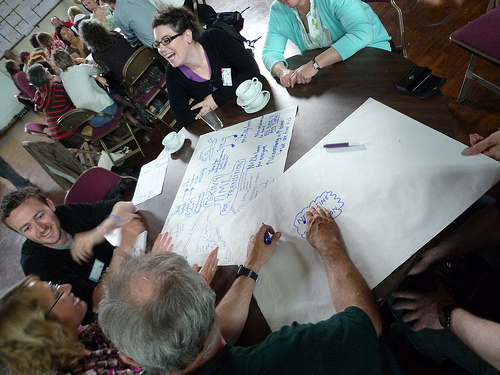Open Space Discussion

Uploaded to Flickr by edmittance
This is an evolving summary of some of the thoughts and ideas that came out of our Open Space discussion at UBC's Educamp 2010 on March 18th, 2010.
Open Space Background
- it's about a self organizing meeting space where the agenda is decided by the participants.
- it is loosely based on the ideas involved in an international movement born in the 1980s by an organizational consultant called Harrison Owen - now called Open Space World.
- the facilitation approach is described as Open Space Technology and the accompanying guidelines for doing an Open Space discussion.
- the central principle is that everyone who comes to an open space meeting is passionate about the topic and willing to make a contribution out of that passion.
4 Key Principles
- Whoever comes are the right people: Whoever is attracted to the same conversation are the people who can contribute most to that conversation—because they care.
- Whatever happens is the only thing that could have: We are all limited by our own pasts and expectations. This principle acknowledges we’ll all do our best to focus on NOW– the present time and place– and not get bogged down in what could’ve or should’ve happened.
- Whenever it starts is the right time: The creative spirit has its own time, and our task is to make our best contribution and enter the flow of creativity when it starts.
- When it is over it is over: Creativity has its own rhythm. So do groups. Just a reminder to pay attention to the flow of creativity — not the clock. When you think it is over, ask: Is it over? And if it is, go on to the next thing you have passion for. If it’s not, make plans for continuing the conversation.
Our Theme: Sustaining Engagement
The group's interests were mainly around the first 2 questions - we didn't get to the last 2 in our hour long time block. An opportunity for follow up?
- Is sustained engagement realistic in today’s reality?
- What do you think are the ingredients for sustained engagement?
- How do you sustain your engagement in your work and learning?
- How do we create sustainable learning resources to engage other?
Mindmap
The conversation was captured using mindmapping software to give us a reference for future sessions on the topic. Mindmapping offered a nice approach for capturing a non-linear conversation with many related threads. Thanks to Esther Hsu from Sauder for capturing this for us!
<flashow>http://go.comapping.com/comappingloader.swf?mapid=79589&publishKey=HhCOxY1UWN&embedded=true%7Cwidth=600%7Cheight=300</flashow>